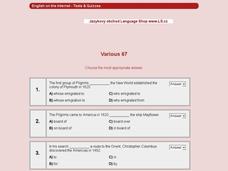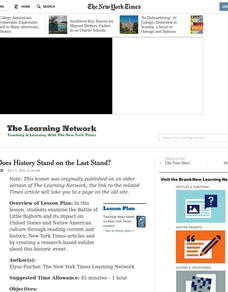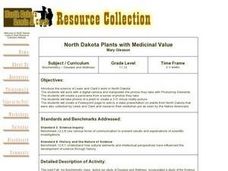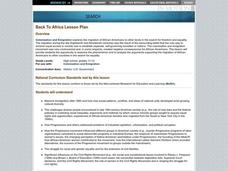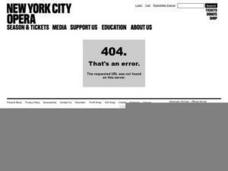Curated OER
Totem Transformations
Students are introduced in the Humanities class, as they explore the origins of Totems in Native American folklore. In the computer lab, students read Totem stories and explore the meaning and symbolism behind the myths using various Web...
Curated OER
Northwest Indian Masks
Learners explore the cultural importance of Native American masks. For this indigenous cultures lesson, students are first introduced to the tribal groups of the Northwest and how they used masks for medicine, religion, and...
Curated OER
Cruising the Harbor
Students read original, primary source account of coming into New York's harbor, compare harbor experiences of Native Americans and Europeans, and explore role of African Americans in waterfront and seafaring activities in New York's...
NYC Department of Records
Citizenship and Elections: The Importance of a Ballot
Approximately 58 prcent of those eligible voted in the 2016 US Presidential election. In an attempt to impress upon learners the importance of voting and voting rights, class members examine primary source documents related to the...
Curated OER
Branching Out
Learners investigate the causes and effects of the spread of tree diseases in the U.S., and research certain American species of trees and the diseases that commonly threaten them. They create pamphlets to help identify healthy and...
Curated OER
General Knowledge of American History #67
In this general knowledge of American history #67 worksheet, 6th graders interactively answer 10 multiple choice questions with immediate online feedback.
Curated OER
Chapter 3 – Antebellum Innovation, Politics, and the Jackson Administration
The inter-war Antebellum Era was a fascinating time in U.S. History! In this textbook response worksheet, historians read assigned textbook pages regarding the topics and respond to 46 short answer display questions regarding the...
Curated OER
Kernels of Wisdom: Investigating Natural Variations in Corn
Here is a brain-popper! Corn, or more appropriately, maize, was intentionally domesticated by humans around 9,000 years ago and over a period of hundreds to thousands of years! Genetics and botany researchers have collaborated to find...
Curated OER
Waste, Then and Now
Students discuss and compare the waste disposal habits of today with those of Native Americans of long ago.
Curated OER
Comparison of American Colonies
Students explore the lifestyles of the American colonies. They conduct various activities according to their grade level including jigsaw research and creating a poster. Lesson includes primary source readings related to the topic.
Curated OER
New York on the Pacific Coast
Pupils explore the interaction and consequences of contact among different ethnic groups. Students examine a timeline and the important historical
events in American History. They discuss immigration and migration.
New York State Education Department
US History and Government Examination: January 2018
It's time to test those skills! Assess pupils' knowledge of US history and government with short answer questions, multiple-choice items, and essays. The resource serves as a standardized test that functions well for a final exam....
New York State Education Department
US History and Government Examination: June 2018
Ready to test your learners about anything and everything related to United States history and government? The resource uses multiple-choice and essay questions to assess knowledge.
K12 Reader
Conflict Over North American Lands
Readers are introduced to some of the conflicts that arose over land and resources in the Americas in a two-part cross-curricular comprehension worksheet that asks kids to study the article and then to use information provided to respond...
Curated OER
Town Growth and Immigration
Fourth graders describe how Michigan has changed and stayed the same over time. They explain reasons why people settled/settle in Michigan, then explain the role of geography on the settlement of Michigan.
Curated OER
Where Does History Stand on the Last Stand?
Students examine the Battle of Little Bighorn and its impact on United States and Native American culture through reading current and historic New York Times articles and by creating a research-based exhibit about this historic event.
Curated OER
A Meat By Any Other Name. . .
Students, using a New York Times article as a springboard, discuss how food reflects different aspects of a culture and reasons why cultural differences in food are seen as bizarre or, oftentimes, cruel by members of other societies.
Curated OER
North Dakota Plants with Medicinal Value
Students use the internet and plant guides and other resources to identify plants and their medicinal importance as seen by the Native Americans. They view a copy of the Lewis and Clark journal that held photos of the plants of their...
Curated OER
Back To Africa
Learners analyze the massive immigration after 1850 and how new social patterns, conflicts, and ideas of national unity developed amid growing cultural diversity, and how the Progressive movement influenced different groups in American...
Curated OER
If These Objects Could Talk
Students examine American Indian artifacts through historical, cultural and artistic lenses. They explore the philosophy behind the Smithsonian Institute's new museum to honor American Indian history and traditions.
Curated OER
Freedom Fighters Throughout American History
Students use the internet to research people who have contributed to the cause of freedom. They identify examples of freedom which are important to them and categorize them. In groups, they create a timeline of the Freedom Fighters and...
Curated OER
Native Species Restoration and its Impact on Local Populations
High schoolers watch video clips of ecosystems and answer questions relating to them.
Curated OER
Picture Writing
Fourth graders create symbols. In this visual arts lesson, 4th graders study cave drawings, Native American pictographs, and Aboriginal Drawings prior to creating their own communication without using words.
Curated OER
Transforming Anansi Folktales Into Storyboards
Students work in small groups to illustrate a story board of a folktale. They develop the meaning of a trickster as a humor device in folktales by listening to several about Leprechauns and the Coyote of Native American tales. They then...







